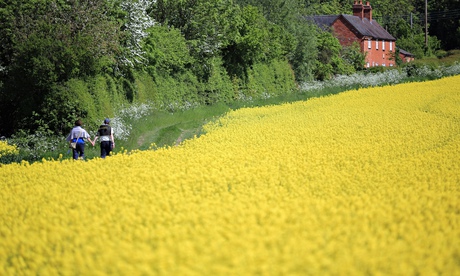
These days it seems like the most popular grains and seeds are those from afar. There is quinoa, the grain of the Andes, chia, the super seed of the Aztecs and Mayans, and from west Africa comes fonio, hoping to be the "new quinoa".
The story of quinoa is a cautionary tale: its popularity internationally drove up prices in South America, making the staple grain for the people of Peru and Bolivia too expensive for them to buy any longer, and turning once diverse crops into a monoculture.
So does Europe have any grains to compete?
"[In Europe] the number of cereal products containing heritage grains, such as emmer … has increased from 9% in 2009 to 13% in 2013," says Tanvi Savara, food and drink analyst at Datamonitor Consumer.
In the UK, spelt has grown from a £250,000 industry in 2004 to around £10m last year. But this increase brings about its own conundrum; prices have spiked and global demand is far beyond British supply, so much so that some British bakers have stopped making spelt bread altogether.
Roger Saul, founder of Sharpham Park, which grows organic spelt, believes he has the media to thank for the upturn in spelt's fortunes. "Health concerns and scares have seen a dramatic increase in journalism in the last year, and as we come out of price concerns a grain like spelt sits at the front of the race," says Saul.
In 2013, the value of UK barley production increased by 21% to £1.1bn, and the value of production of oats increased by 39% to £158m (pdf). However, while it was a good year for barley and oats, the climate meant that 2013 was the second year in a row that wheat production was below average, making the UK a net importer of wheat for 2013.
Vito Martielli, senior grains and oilseeds analyst at Rabobank, says that this is not a huge concern, given that the EU is a net exporter of wheat and that some of the wheat producing countries have not reached their full potential yet. In Germany, for example, wheat producers get about eight tonnes per hectare, while in Romania it sits at about three to four tonnes. With improved farming technology and farm inputs those yields can easily be increased.
While quinoa and other exotic grains remain popular, the market is expanding for foods more reflective of local food culture in Europe. According to consumer research by Datamonitor Consumer, 41% of Europeans consider it reasonable to charge at least 10% extra for a local product.
Yet as with all food, it is a matter of shopping mindfully. "In order for the consumer to know what they are buying, labels have to be read and questions asked about the source of the food. Unfortunately the weekly supermarket shop is usually done at a gallop in order to get out," says Terence Pardoe of Coastal Grains Ltd, a grain cooperative in Northumberland.
Today, 60% of the plant-derived calories that we eat come from rice, maize and wheat, which means it is time to diversify. While that box of quinoa may look tempting, for those based in Europe there are plenty of grains and seeds grown closer to home.
1. Barley
A traditional grain across many parts of Europe, barley is often used for malt brewing but with a nutty flavour and chewy consistency, can be a good replacement for pasta. Barley has a high percentage of dietary fibre and an assortment of vitamins and minerals.
2. Oats
Poland is Europe's largest producer of oats, followed by Spain and Finland. A versatile grain high in protein and fibre content, oats are increasingly used to make non-dairy milks.
3. Spelt
Also known as dinkel wheat, spelt has long been a staple crop in Europe. Containing gluten, it is suitable for baking, while in Poland it is distilled to make vodka.
4. Buckwheat
Native to northern parts of Europe and parts of Asia, buckwheat is used in its seed form and milled as a flour. It is the base of French savoury crepes, and buckwheat groats can be made into hot cereal. While it is often mistaken for a grain, it is actually a seed, and in turn, gluten-free.
5. Rapeseed
Related to mustard, cabbage, broccoli, and cauliflower, the yellow flowering plant is cultivated in many parts of Europe and can be turned into oil, a good source of essential fatty acids. Rapeseed oil can be an excellent local alternative to olive oil. "Rapeseed oil from a cold pressed production system is far healthier that olive oil and cooks at a higher temperature," says Pardoe. "But we have all been brainwashed over the last thirty years into thinking that olive oil is part of a long life and healthy diet."
Anna Brones is a freelancer and author of The Culinary Cyclist. She runs the website Foodie Underground.
The food hub is funded by The Irish Food Board. All content is editorially independent except for pieces labelled advertisement feature. Find out more here.
Join the community of sustainability professionals and experts. Become a GSB member to get more stories like this direct to your inbox

